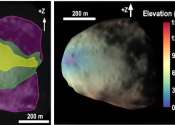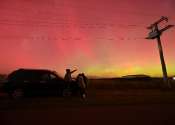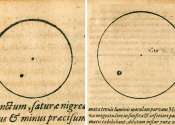Last update:
Planetary Sciences news

Astronomers use AI to find elusive stars 'gobbling up' planets
Astronomers have recently found hundreds of "polluted" white dwarf stars in our home galaxy, the Milky Way. These are white dwarfs caught actively consuming planets in their orbit. They are a valuable resource for studying ...
Astronomy
2 hours ago
0
66

A unique combination of antennas could revolutionize remote sensing
Bigger antennas are better, at least according to researchers interested in geospatial monitoring. That's because higher resolution in monitoring applications requires larger apertures. So imagine the excitement in the remote ...
Planetary Sciences
2 hours ago
0
16

A new study shows how the sun could permanently capture rogue planets
Interest in interstellar objects (ISOs) was ignited in 2017 when 'Oumuamua flew through our solar system and made a flyby of Earth. Roughly two years later, another ISO passed through our solar system—the interstellar comet ...
Planetary Sciences
3 hours ago
0
2

Predicting solar storms before they leave the sun
When giant solar storms hit Earth, they trigger beautiful auroral displays high in Earth's atmosphere. There's a dark side to this solar activity, though. The "space weather" it sets off also threatens our technology. The ...
Planetary Sciences
4 hours ago
0
14

NASA smacked a spacecraft into an asteroid—and learned details about its 12-million-year history
NASA's DART mission—Double Asteroid Redirection Test—was humanity's first real-world planetary defense mission.
Astronomy
Jul 31, 2024
0
31

How to SUPPPPRESS light from a star that is ten billion times brighter than its habitable exoplanet
Searching for Earth 2.0 has been an obsession of almost all exoplanet hunters since the discipline's dawn a few decades ago. Since then, they've had plenty of technological breakthroughs help them in their quest, but so far, ...
Planetary Sciences
Jul 31, 2024
0
18

Astrophysicists build model to explain to rapid planet formation
Our solar system is our immediate cosmic neighborhood. We know it well: the sun at the center; then the rocky planets Mercury, Venus, Earth, and Mars; and then the asteroid belt; followed by the gas giants Jupiter and Saturn; ...
Planetary Sciences
Jul 31, 2024
0
32

Additional planet orbiting the star TOI-1408 discovered
Using NASA's Transiting Exoplanet Survey Satellite, an international team of astronomers has detected a second planet orbiting a distant main sequence star known as TOI-1408. The newfound alien world, designated TOI-1408 ...

DART mission sheds new light on target binary asteroid system
In studying data collected from NASA's DART (Double Asteroid Redirection Test) mission, which in 2022 sent a spacecraft to intentionally collide with the asteroid moonlet Dimorphos, the mission's science team has discovered ...
Astronomy
Jul 30, 2024
0
177

The discovery of a new Earth-like planet could shed further light on what makes a planet habitable
In an exciting breakthrough for astronomy and the search for extraterrestrial life, a team of international scientists has announced the discovery of Gliese 12 b, a temperate, Earth-sized exoplanet just 40 light-years away—a ...
Astrobiology
Jul 30, 2024
0
52

Solar storms could cause more auroras
Massive explosions on the sun have triggered warnings of geomagnetic storms that could create dazzling auroras in the northern United States, Europe and southern Australia from Tuesday night.
Planetary Sciences
Jul 30, 2024
0
161

Study suggests cloud-to-ground lightning strikes may have generated building blocks for life on Earth
A large team of chemists at Harvard University has found evidence suggesting that cloud-to-ground lightning strikes may have helped generate some of the building blocks needed for life on Earth to arise.

Has NASA found evidence of ancient life of Mars? An expert examines the latest discovery
NASA has announced the first detection of possible biosignatures in a rock on the surface of Mars. The rock contains the first martian organic matter to be detected by the Perseverance rover, as well as curious discolored ...
Astrobiology
Jul 29, 2024
0
53

NASA Mars rover captures rock that could hold fossilized microbes
NASA's Perseverance Mars rover has made what could be its most astonishing discovery to date: possible signs of ancient life on the Red Planet.
Planetary Sciences
Jul 27, 2024
0
120

Spacecraft to swing by Earth, moon on path to Jupiter
A spacecraft launched last year will slingshot back around Earth and the moon next month in a high-stakes, world-first maneuver as it pinballs its way through the solar system to Jupiter.
Space Exploration
Jul 27, 2024
0
59

Is this how you get hot Jupiters?
When we think of Jupiter-type planets, we usually picture massive cloud-covered worlds orbiting far from their stars. That distance keeps their volatile gases from vaporizing from stellar heat, similar to what we're familiar ...
Planetary Sciences
Jul 26, 2024
0
43

How solar storms play havoc with our lives
Despite the 150 million kilometers that separate it from the Earth, the sun does more than just light our way: it also impacts our electricity networks, and even our transport.
Planetary Sciences
Jul 26, 2024
0
38

Kepler's 1607 pioneering sunspot sketches solve solar mysteries 400 years later
Using modern techniques, researchers have re-examined Johannes Kepler's half-forgotten sunspot drawings and revealed previously-hidden information about the solar cycles before the grand solar minimum.
Planetary Sciences
Jul 26, 2024
0
98

Perseverance rover discovers rock with potential signs of ancient life
A vein-filled rock is catching the eye of the science team of NASA's Perseverance rover. Nicknamed "Cheyava Falls" by the team, the arrowhead-shaped rock contains fascinating traits that may bear on the question of whether ...
Astrobiology
Jul 25, 2024
0
245

A pair of CubeSats using ground penetrating radar could map the interior of near-Earth asteroids
Characterizing near-Earth asteroids (NEAs) is critical if we hope to eventually stop one from hitting us. But so far, missions to do so have been expensive, which is never good for space exploration.
Planetary Sciences
Jul 25, 2024
0
5
More news

What lunar caves tell us about the shared origins of the Earth and the moon

Image: A Saturnian summer

NASA's ICON mission ends with several ionospheric breakthroughs

Chinese lunar probe finds water in moon samples

NASA rocket discovers new energization process in upper atmosphere

Moon dust could contaminate lunar explorers' water supply

Introducing Ramses, ESA's 2029 mission to asteroid Apophis

NASA's Curiosity rover discovers a surprise in a Martian rock

A new explanation for Jupiter's shrinking Great Red Spot
Other news

Microscopy breakthrough promises better imaging for sensitive materials

Plant biologists discover an ancient gene family is responsible for plant prickles across species

Researchers uncover 500 million-year-old mollusk ancestor

When it comes to DNA replication, humans and baker's yeast are more alike than different, scientists discover

How duplicated genomes helped grasses diversify and thrive

Uniquely precise: New value for the half-life of samarium-146

Ground conditions can impact lunar swirls, study finds

Exoplanet-hunting telescope to begin search for another Earth in 2026

Grain boundaries weaken in planetary interiors, research suggests

New ultra-hot Neptune-sized exoplanet discovered

New perspectives for using corals in climate research

Scientists using new sound tech to save animals from extinction
















































